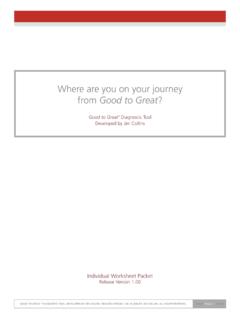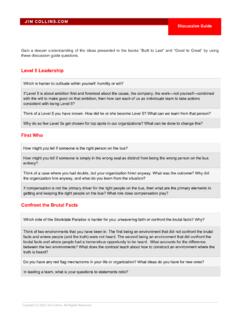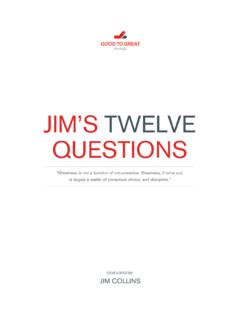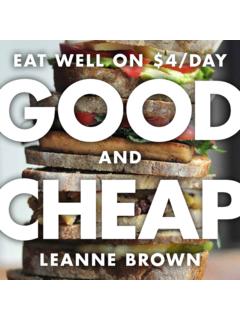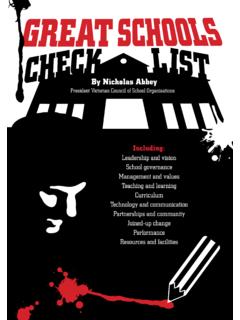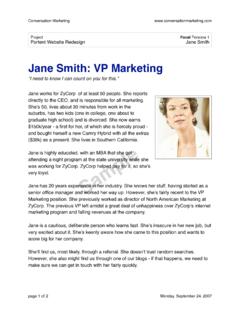Transcription of Amazon.com system into the biggest, most ... - Good to Great
1 A good to Great Strategic ToolJim CollinsIn 2001, invited me to engage in a spirited dialogue with founder Jeff Bezos and a few members of his executive team. This was right in the middle of the dot-com bust, when some wondered how (or if) Amazon could recover and prevail as a Great company. Drawing upon the findings from our soon-to-be released book good to Great , I shared one of its key findings, the flywheel effect. In creating a good -to- Great transformation, there s no single defining action, no grand program, no single killer innovation, no solitary lucky break, no miracle moment; rather, the process resembles relentlessly pushing a giant, heavy flywheel, turn upon turn, building momentum until a point of breakthrough and beyond. Once you fully grasp how to create flywheel momentum in your particular circumstance, and apply that understanding with creative intensity and relentless discipline, you get the power of strategic compounding. Never underesti-mate the power of momentum, especially when it compounds over a very long time.
2 Once you get your flywheel right, you want to stay with it for years to decades decision upon decision, action upon action, turn by turn each loop adding to the cumulative effect. But to best accomplish this, you need to understand how your specific flywheel turns. The Amazon team grabbed the flywheel concept to articulate the drivers in its business, as Brad Stone wrote in The Everything Store, Bezos and his lieutenants sketched their own virtuous cycle, which they believed powered their business. It went something like this: Lower prices led to more customer visits. More customers increased the volume of sales and attracted more commission-paying third-party sellers to the site. That allowed Amazon to get more out of fixed costs like the fulfillment centers and the servers needed to run the website. This greater efficiency then enabled it to lower prices further. Feed any part of this flywheel, they reasoned, and it should accelerate the loop. And so the flywheel would turn, building momentum.
3 Push the flywheel; accelerate momentum. Then repeat, then again, and again, and again. Bezos, Stone continued, considered Amazon s application of the flywheel concept the secret sauce. One of the biggest strategic mistakes you can make is to fail to make the most of your victories. Yet even brilliant leaders sometimes make this mistake. One reason they fail is if they are obsessively searching for the Next Big Thing. And sometimes you do find the Next Big Thing. Yet our research in How the Mighty Fall, wherein we examined why and how once- Great companies bring about their own senseless self-destruction, revealed that those who drive companies into decline often abandon the big thing they already have, grasping instead for a new big thing, then another and another, falling into a doom loop of chronic inconsistency. Conversely, those who build and sustain the greatest and most enduring organizations fully capitalize on their successful big bets, rather than abandon them prematurely.
4 This doesn t mean they mindlessly repeat what they ve done before. It means evolving, exploiting, expanding, extending. It doesn't mean just selling books online; it means extending and evolving the system into the biggest, most comprehensive e-commerce store in the world. The Amazon team could have panicked during the dot-com bust and succumbed to frantic lurching about. Instead, Bezos and his executives gained disciplined understanding of the Amazon flywheel and then innovated aggressively within that flywheel to build and accelerate momen-tum. Amazon not only survived but also became one of the most successful and enduring companies to emerge from the dot-com era. The Amazon case illustrates that you can gain tremendous strategic insight when you identify the primary components in your flywheel and understand how they best link together. Here, I ve sketched the essence of the original Amazon flywheel to illustrate the idea. Notice something: in both the Amazon and Vanguard cases, leaders conceptualized an underlying strategic compounding machine that they'd already built and validated in practice.
5 They didn t ask, "What flywheel would we like to have?" They asked, "What flywheel actually works for us, and why?" In the years after first blueprinting their flywheels, both Amazon and Vanguard made tweaks and extended their flywheels into new arenas. Vanguard extended into exchange-traded funds (mutual funds that can be traded like an individual stock), for example, and Amazon went far beyond its original website. But the basic architectures of their strategic compounding machines remained very much intact. I ve written this short article as a tool to help you do for your enterprise what the Amazon and Vanguard teams did for themselves to conceptualize and diagram your flywheel, so that you can consciously harness the flywheel effect. To illustrate what a diagrammed flywheel might look like, here are a few additional sketches drawn from our research database or direct experiences: Giro Sport Design, Intel, and the Cleveland Clinic. To be clear, all the examples in this article reflect my own take on the flywheel from each case; the leaders who built these flywheels could likely draw them with more nuance than I have here.
6 Think of these diagrams simply as illustra-tive sketches to stimulate thinking about your own flywheel. Jim Gentes and Bill Hanneman at Giro Sport Design built their flywheel around an insight gained from studying Nike and validated by their first big successful product, the Giro bicycle helmet: there s a hierarchy of social influence for athletic gear. If, for instance, you get a Tour de France winner to wear your bicycle helmet, then serious non-professional cyclists will want to wear that helmet, which then starts the cycle of influence and builds the brand. From this insight, Gentes and Hanneman built a powerful flywheel: invent Great products, get elite athletes to use them, inspire Weekend Warriors to mimic their heroes, attract mainstream customers, build brand power as more and more athletes use the products, set high prices and channel profits back into R&D, which brings us right back to the top of the loop. pg 1 Copyright 2017 by Jim Collins, All Rights ReservedIn 2001, invited me to engage in a spirited dialogue with founder Jeff Bezos and a few members of his executive team.
7 This was right in the middle of the dot-com bust, when some wondered how (or if) Amazon could recover and prevail as a Great company. Drawing upon the findings from our soon-to-be released book good to Great , I shared one of its key findings, the flywheel effect. In creating a good -to- Great transformation, there s no single defining action, no grand program, no single killer innovation, no solitary lucky break, no miracle moment; rather, the process resembles relentlessly pushing a giant, heavy flywheel, turn upon turn, building momentum until a point of breakthrough and beyond. Once you fully grasp how to create flywheel momentum in your particular circumstance, and apply that understanding with creative intensity and relentless discipline, you get the power of strategic compounding. Never underesti-mate the power of momentum, especially when it compounds over a very long time. Once you get your flywheel right, you want to stay with it for years to decades decision upon decision, action upon action, turn by turn each loop adding to the cumulative effect.
8 But to best accomplish this, you need to understand how your specific flywheel turns. The Amazon team grabbed the flywheel concept to articulate the drivers in its business, as Brad Stone wrote in The Everything Store, Bezos and his lieutenants sketched their own virtuous cycle, which they believed powered their business. It went something like this: Lower prices led to more customer visits. More customers increased the volume of sales and attracted more commission-paying third-party sellers to the site. That allowed Amazon to get more out of fixed costs like the fulfillment centers and the servers needed to run the website. This greater efficiency then enabled it to lower prices further. Feed any part of this flywheel, they reasoned, and it should accelerate the loop. And so the flywheel would turn, building momentum. Push the flywheel; accelerate momentum. Then repeat, then again, and again, and again. Bezos, Stone continued, considered Amazon s application of the flywheel concept the secret sauce.
9 One of the biggest strategic mistakes you can make is to fail to make the most of your victories. Yet even brilliant leaders sometimes make this mistake. One reason they fail is if they are obsessively searching for the Next Big Thing. And sometimes you do find the Next Big Thing. Yet our research in How the Mighty Fall, wherein we examined why and how once- Great companies bring about their own senseless self-destruction, revealed that those who drive companies into decline often abandon the big thing they already have, grasping instead for a new big thing, then another and another, falling into a doom loop of chronic inconsistency. Conversely, those who build and sustain the greatest and most enduring organizations fully capitalize on their successful big bets, rather than abandon them prematurely. This doesn t mean they mindlessly repeat what they ve done before. It means evolving, exploiting, expanding, extending. It doesn't mean just selling books online; it means extending and evolving the system into the biggest, most comprehensive e-commerce store in the world.
10 The Amazon team could have panicked during the dot-com bust and succumbed to frantic lurching about. Instead, Bezos and his executives gained disciplined understanding of the Amazon flywheel and then innovated aggressively within that flywheel to build and accelerate momen-tum. Amazon not only survived but also became one of the most successful and enduring companies to emerge from the dot-com era. The Amazon case illustrates that you can gain tremendous strategic insight when you identify the primary components in your flywheel and understand how they best link together. Here, I ve sketched the essence of the original Amazon flywheel to illustrate the idea. FlywheelGrow Revenues Per Fixed CostsLower Prices on More OfferingsIncrease Customer VisitsExpand the Store, Extend DistributionAttract Third Party our management lab in Boulder, Colorado, we've challenged executive teams to diagram the essence of their flywheels as an integral step in creating and sustaining good -to- Great break-throughs.

